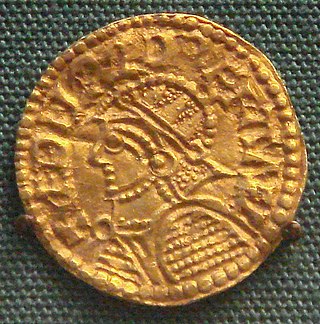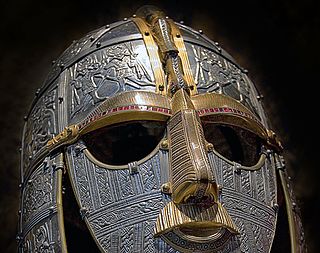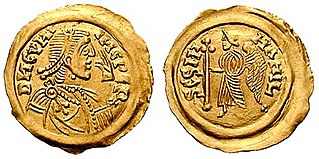A moneyer is a private individual who is officially permitted to mint money. Usually the rights to coin money are bestowed as a concession by a state or government. Moneyers have a long tradition, dating back at least to ancient Greece. They became most prominent in the Roman Republic, and continued into the Empire. In Rome the position of Triumvir Monetalis, held by three people at a time, was a minor magistracy awarded by the Senate, often the first office held by young politicians, including Marcus Aurelius.

Clovis III was the Frankish king of Austrasia in 675 and possibly into 676. A member of the Merovingian dynasty, he was a child and his reign so brief and contested that he may be considered only a pretender. He is sometimes even left unnumbered and Clovis IV is instead called Clovis III. The only source for his reign is the contemporary Suffering of Leudegar.

Æthelstan was king of East Anglia in the 9th century, the first East Anglian king after a century of Mercian domination. As with the other kings of East Anglia, there is very little textual information available. Æthelstan did, however, leave an extensive coinage of both portrait and non-portrait type. His reign cannot be precisely dated, but was likely from c. 827 to c. 840.

Audeca or Andeca was the last Suevic King of Galicia from 584 until his deposition in 585. He deposed Eboric and usurped the throne by marrying the young king's mother, Siseguntia, the widow of Eboric's father and predecessor, Miro. He consigned Eboric to a monastery.

The tremissis or tremis was a small pure gold coin of Late Antiquity. Its name, meaning "a third of a unit", formed by analogy with semissis, indicated its value relative to the solidus. It was introduced into Roman currency in the 380s by the Emperor Theodosius I and initially weighed 8 siliquae.

Mancus was a term used in early medieval Europe to denote either a gold coin, a weight of gold of 4.25g, or a unit of account of thirty silver pence. This made it worth about a month's wages for a skilled worker, such as a craftsman or a soldier. Distinguishing between these uses can be extremely difficult: the will of the Anglo-Saxon king Eadred, who died in 955, illustrates the problem well with its request that "two thousand mancuses of gold be taken and minted into mancuses".
Philip Grierson, was a British historian and numismatist. He was Professor of Numismatics at Cambridge University and a fellow of Gonville and Caius College for over seventy years. During his long and extremely prolific academic career, he built the world's foremost representative collection of medieval coins, wrote very extensively on the subject, brought it to much wider attention in the historical community and filled important curatorial and teaching posts in Cambridge, Brussels and Washington DC.
The Sylloge of the Coins of the British Isles (SCBI) is an ongoing project to publish all major museum collections and certain important private collections of British coins. Catalogues in the series contain full details and illustrations of each and every specimen. Every Anglo-Saxon and Norman coin included in the project can be viewed on the SCBI Database, based at the Department of Coins and Medals, Fitzwilliam Museum, Cambridge.

Tarì was the Christian designation of a type of gold coin of Islamic origin minted in Sicily, Malta and Southern Italy from about 913 to the 13th century.

Coinage in Anglo-Saxon England refers to the use of coins, either for monetary value or for other purposes, in Anglo-Saxon England.

The thrymsa was a gold coin minted in seventh-century Anglo-Saxon England. It originated as a copy of Merovingian tremisses and earlier Roman coins with a high gold content. Continued debasement between the 630s and the 650s reduced the gold content in newly minted coins such that after c. 655 the percentage of gold in a new coin was less than 35%. The thrymsa ceased to be minted after about 675 and was superseded by the silver sceat.
Sitric was a Viking leader who may have co-ruled Viking Northumbria in the 10th century. No contemporary texts mention Sitric and his existence is only evidenced by coins bearing his name which were minted at York in c. 942.

The coinage of the Lombards refers to the autonomous productions of coins by the Lombards. It constitutes part of the coinage produced by Germanic peoples occupying the former territory of the Roman Empire during the Migration Period. All known Lombard coinage was produced after their settlement of Italy. The coinage originates from two distinct areas, in Langobardia Major between the last decades of the sixth century and 774, and in Langobardia Minor, in the duchy of Benevento, between approximately 680 and the end of the 9th century.

Lucia Travaini is an Italian numismatist, archaeologist, and academic. She is an Associate Professor of Medieval and Modern Numismatics at the University of Milan.
The Traité de numismatique du moyen âge was a survey of European medieval coinage by Arthur Engel (1855-1935) and Raymond Serrure (1862-99) issued in three volumes between 1891 and 1905. Arthur Engel was an archaeologist and numismatist, a member of the French Society of Numismatics and the Society of Antiquarians. He was also a member of the French Schools in Rome and Athens. Raymond Surrure's father and grandfather had been noted numismatists. He traded as a coin dealer in Paris and after his death his widow carried on his business until 1913.
The Buis hoard was a hoard of Merovingian gold coins found in a vegetable patch at Buis around 1855. There were about 300 to 400 coins in the hoard when local antiquary Anatole de Charmasse saw them in 1873, identified 55 types, took down legends and drew sketches. They have since been dispersed. Most recently, Jean Lafaurie has identified 76 coins from the hoard: 75 Merovingian tremisses and one Arab-Byzantine dīnār from Damascus. Eleven of the coins came from the mint of Chalon-sur-Saône and the latest datable Merovingian issue was struck in the name of Chlothar II at Marseille between 612 and 629. Pierre Le Gentilhomme, who first published the find in 1938, concluded that it was most likely deposited in the 640s, based on the sequence of moneyers from Chalon. It may have been buried in connection with the battle of Autun and the death of Willibad in September 642 or 643, since according to the Chronicle of Fredegar this was followed by much unrest and plundering.
Martin Allen, FSA, is a British numismatist and historian, specialising in medieval English coinage. Allen is the Senior Assistant Keeper of Numismatics at the Fitzwilliam Museum in Cambridge, United Kingdom.
The St Leonard's Place hoard was a hoard of c. 10,000 early medieval Northumbrian coins known as stycas, discovered by workers during construction work at St Leonard's Place in York in 1842. Many of the coins were subsequently acquired by the Yorkshire Museum.

The Lombard coinage of Benevento, part of the more general Lombard coinage, is the set of coins minted between about 680 and the end of the ninth century in the duchy and principality of Benevento. Solidi and tremisses, both gold coins that imitated those of the Eastern Roman Empire, were first minted; later followed the issuance of coins in the names first of the dukes and then of the Benevento princes. Toward the end of the 8th century alongside the gold coins were minted silver coins, which gradually took the place of the earlier ones, as moreover happened in the rest of Western Europe. Silver became the prevalent coinage metal only from the mid-9th century.

The coinage of Adelchis, prince of Benevento, constitutes a special chapter in the Lombard coinage of Benevento and bears witness to the political changes that took place during his principality. The period in which Adelchis minted runs from 854, when he became prince of Benevento, to 878; his coinage is centered on the denier, a silver coinage that became widespread in Europe following Charlemagne's rise to power.













